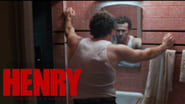robertandrewbacon
I was completely blown away by this film and have no idea why it's not more popular. The acting is amazing, the script is fantastic, and it's wonderfully directed. There are scenes in this film that will stay with me forever because they feel so real.
Red-Barracuda
This highly controversial film was made in 1986 but struggled to find proper distribution until 1990. It's not necessarily difficult to understand why it was considered so troubling, as it was made at a time when there was a plethora of American slasher movies being released left right and centre but Henry was noticeably different from those. Where the likes of the Jason, Michael and Freddie films were clear examples of pure horror movies, with the comforting distance that provides, Henry was a downbeat psychological drama which never sensationalised its material but instead presented it starkly and realistically. Needless to say, this approach caused it many problems, as if there is one thin g that the history of cinema has shown it is that if you veer too close to reality you could be in trouble. As such, this is a very disturbing study of a serial killer, presented with clinical detachment and a complete absence of camp elements. Its characters are loosely based on the real serial killers Henry Lee Lucas and Otis O'Toole. But the story is definitely different to that particular grim reality.While the film has much extreme imagery and sequences, such as the opening montage of dead women and the highly sinister videotaped house invasion, things are always underplayed with an accent on a realistic portrayal of the characters. All three principal actors do very fine work indeed but it is Michael Rooker in the title role that particularly stands out. His is a chillingly convincing portrayal of a psychopath, who is shown clearly to have a personality disorder, yet can operate more-or-less efficiently on a surface level to convince a woman that he is a reliable character. Rooker totally nails it in terms of presenting such a character in an unglamourised fashion where we simultaneously can see his soulless brutality and inability to function in society, while also showcasing how he could still convince others otherwise. It is a brilliantly skilled interpretation.This is undoubtedly not a film for all tastes. While it is labelled as a horror, it lacks the rollercoaster element of slasher films and operates decidedly more as a serious-minded bit of challenging cinema. It ends in a manner in keeping with its overall intent in a deeply nihilistic way but this is the only ending which would have been true to the material of course. The film as a whole remains potent to this day and still is one of the very few movies with the nerve to present the grim reality of the psychopath on screen.
AGDeac
"Henry: Portrait of a serial killer" belongs to a certain type of films which are not wanted but needed.
The film raised many controversies ever since it's initial release, and nobody who already watched it wonders why. It's disgusting, violent, raw, but most of all it is honest. Imagine a combination of "Peeping Tom" and "The Texas Chain Saw Massacre" and now amplify the final result.
The media and the society itself has always been fascinated about killers for several reasons: why they do it, how they get away with it, but most of all how they do it. The final question never got a fair answer in cinematography until Henry came along.
An extremly low-budget film, "Henry" manages to create reactions only because of it's honesty, showing explicit scenes of violence through the eyes of a tormented man. The characters are unhappy and live in a grey world where boredom is a routine and it destroys people from the inside.
Infamous scenes like the one when Henry (Micharl Rooker) and Otis (Tom Towells) watch a tape of their own murderous acts ruin society's fascination about serial killers. Most people will not want to watch this movie a second time, but everyone should watch it at least once. It may lack the vegetarian message of "The Texas Chain Saw Massacre" or the love story of "Peeping Tom", but it shows us how reality is like and it doesn't lie to us about serial killers and violence. Henry is the " Unforgiven" of horror film.
jzappa
What makes Henry: Portrait of a Serial Killer so harrowing, so numbing, is the absence of any judgment of the characters. The film was shot on 16mm film in one month's time for $110,000 in 1985. It did not premiere until 1990, and became one of a handful of international independent films to instigate the NC-17 rating. It does not contain buckets of blood, nor is it particularly explicit sexually. It is, from any and every angle, an omniscient portrait. Two naked women are shown dead, having already been brutally murdered, one in a field and the other in a bedroom, while a troubled man named Henry drives around Chicago. We hear their screams. All we see are their mangled bodies. That is all we need. And it is stomach-churning.Itinerant Henry and his prison buddy Otis are cold-blooded and chillingly casual murderers. Played by gravelly character actor Michael Rooker, Henry never appears or behaves like anyone out of the ordinary. We get the sense that he hardly ever thinks about murder, except for when he does it. As for Otis, played by the imposing Tom Towles, think of when you smoke a pack of cigarettes a day, versus one after your morning coffee and one after dinner. Think of the discipline and organization inherent in the latter. That's Otis's problem kind of, only he's not just the one pack a day, he's about five and the tobacco is laced with children's tears. That's why he truly brings out the things about individuals we never see. He does many unforgivably monstrous things here, but he still manages to go about his business without remorse or fear of getting caught, so we presume he's just a good ol' boy with a short fuse. And he is; he just goes a few steps further than most.Portrait is not about the thin line between good and evil. Portrait sees no line. There are innumerable films about serial killers. It is a permanent fixture in the Middle American zeitgeist. We fear them, so we turn them into our own bloodthirsty entertainment. They have become mythology for us to use in order to take our morbid curiosities and sadistic fantasies out for a safe spin. Even after this definitive film on the subject, it is not often that a movie dares to portray the real ones, unmitigated by thriller tropes.John McNaughton and his late collaborator Richard Fire do not feel the need to pigeonhole or explain them, not just as movie characters but as people. Without a frame of compromise, McNaughton defies the hankering to pump up the volume, to frame Henry in chiaroscuro or Otis with Dutch angles. When most human beings see the things that Henry and Otis actually go through with---feeling no other rationale, it would seem, than that it's simply something for them to do---our immediate reaction is to ask how someone could do such things, and why. As Nick Nolte says as a homicide detective in Ole Bornedal's 1997 thriller, "Even when we catch the killer, they wanna know the how and why."That character would agree with McNaughton and Fire that people like Henry and Otis, are well beyond the need to justify what they do. What explanation could there be for slaughtering an entire random family, while recording the whole incident on a camcorder to then watch it later with the blank beer-chugging catatonia of watching an inning of baseball? Horror films, though designed to scare us, are also designed to make us feel safe. The killer was humiliated by his quarries in high school, or has split personality disorder. This film is not a horror film. Explanations are just a fiction to make us feel safe. This film does not have explanations. It has events, key moments in the lives of guys who like to drink beer, smoke weed, hang out with Otis' sister and kill random strangers.








